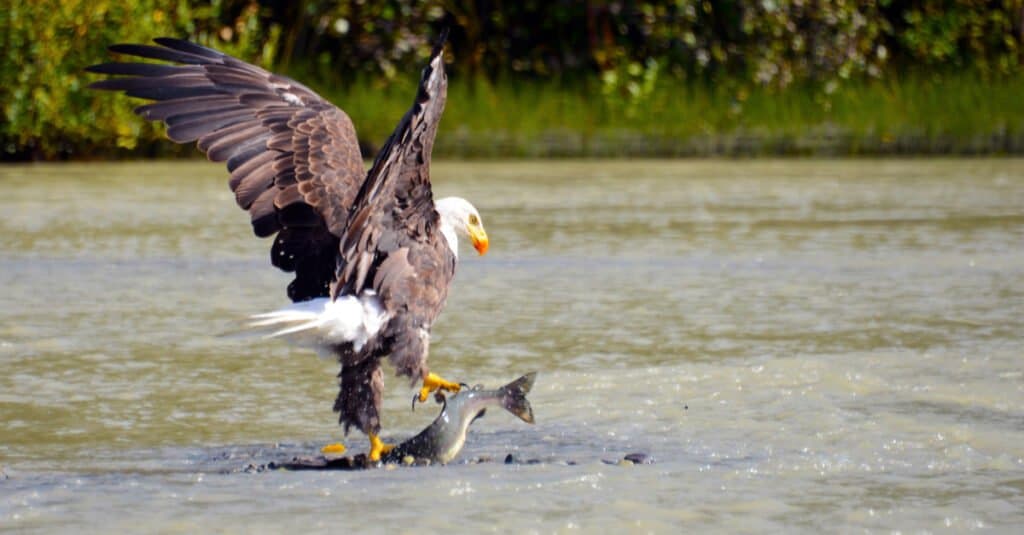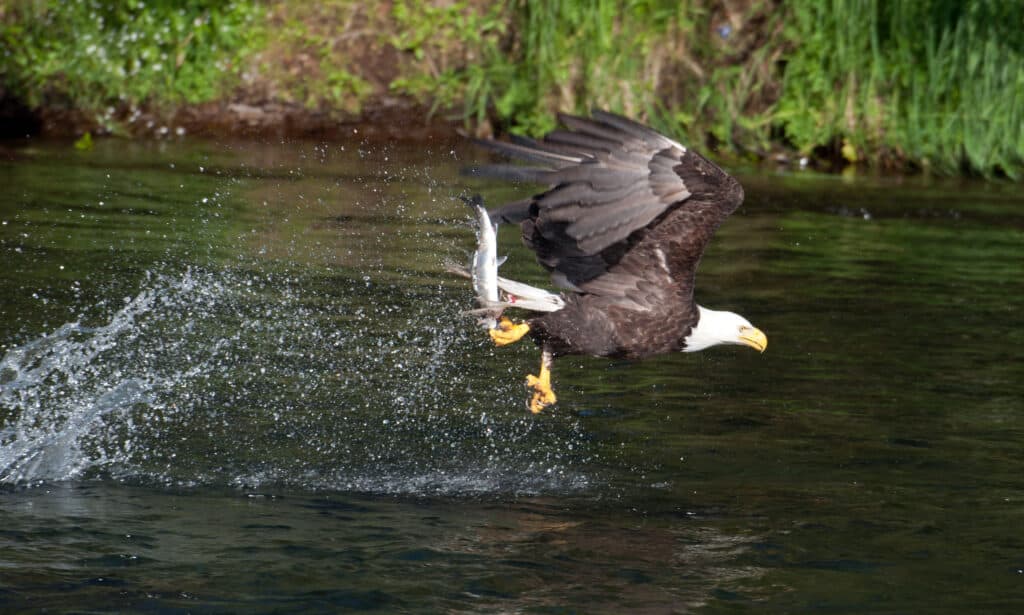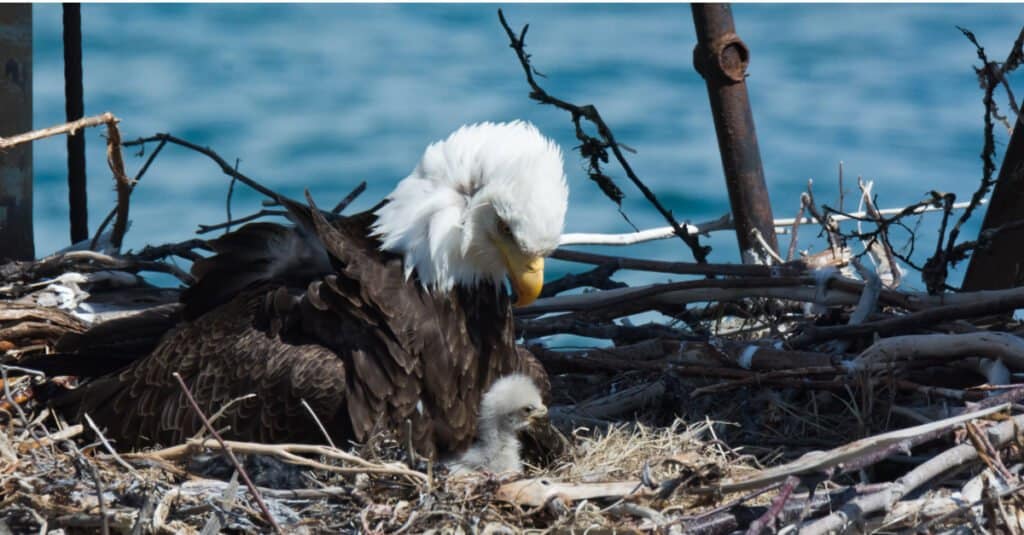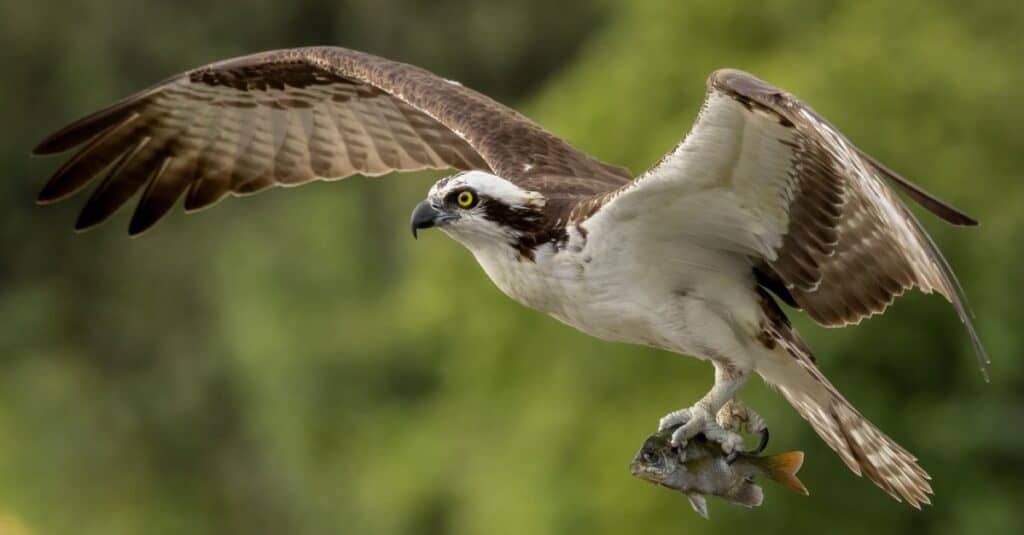Continue reading for our analysis...

Bald eagles are incredibly magnificent — and incredibly bold. This amazing moment caught on video made FOX13 Tampa Bay news.
The video starts with a serene view of quiet waters with the sun setting in the background. A man stands in the foreground with blue shorts, a jacket, and a sports cap.
Just ahead of him, there is some commotion in the water and as he moves over, you can see his fishing pole beginning to pull something out of the water.
He keeps slowly reeling in a small bonnet shark and another man is seen assisting him by pulling on the fishing line. The next moment happens so quickly, that all onlookers are left in shock.
Just as the second man approaches and begins pulling the small shark in by tugging at the fishing line, a bald eagle swoops in from the right of the screen to capture the shark with its powerful claws.
It happens in the flash of an eye, and you can hear the onlookers’ sounds of surprise as they process what has just happened.

Bald eagles have been known to steal fish and other prey from people fishing.
©Jack Molan/Shutterstock.com
The small bonnet shark is still hooked to the line, so the bald eagle stops and stays standing on top of the shark in the shallow water. It looks around, taking in the humans standing on the shore just ahead of it as if to say, “It’s mine.”
No argument there from the fisherman or anyone else standing on the shore.
The group of surprised onlookers shouts “Take a picture!” And you can hear some shuffling about as the people taking in this unbelievable scene gather to capture the moment for themselves.
The bald eagle holds its ground, remaining atop the small shark while it flaps its large wings. The shark wriggles beneath the bald eagle, still attempting to fight for its life. The man with the fishing pole is amazed and ecstatic as he tries to figure out how to cut the hook so the bald eagle can enjoy its stolen catch.
The man waits a few moments to let onlookers take more photos before he begins to move in. The bald eagle starts nipping at the shark, and then the video cuts to a slow-motion replay of the moment when the bald eagle took the bonnet shark from the fisherman.
Is It Normal for Bald Eagles to Steal Food From Humans?
The simple answer to this question is yes. If bald eagles see an opportunity to steal food from humans or other birds, they will certainly do so.
Bald eagles have been known to steal fish and other types of prey from fishermen and other animals. Fishermen have fallen victim to bald eagles and have lost prized catches due to eagles.
The bald eagle is a scavenger bird and can be a bit of a bully. They will aggressively take and steal food until they are satisfied.

Bald eagles can lift several pounds with their strong talons.
©jbieger/Shutterstock.com
How Large Do Bald Eagles Get?

Bald eagles have a wingspan of 6.6 feet.
©Harry Collins Photography/Shutterstock.com
The grown-up male measures around 36 inches in length and has a wingspan of 6.6 feet. The bald eagle is only found in North America. Bald eagles can weigh between 8 to 12 pounds. While the bald eagle is a larger predator bird, the harpy eagle (Harpia harpyja) is the most powerful bird of prey in the world.
Where Do Bald Eagles Live?
Bald eagles can be found in many areas across North America, including Canada, the United States, and Mexico. They typically inhabit large bodies of open water with an abundant food supply. In addition to these countries, bald eagles have been seen around the world in places like Russia, Scandinavia, and China.
Their preferred habitat is near rivers or lakes, but they are also known to live along coasts and on islands. Bald eagles migrate seasonally between different nesting sites depending on where they can find adequate prey and suitable nesting locations.
Additionally, some populations of bald eagles winter in Florida or other southern states during colder months when their northern habitats become too cold for them to survive.

Salmon is a favorite food for bald eagles.
©Tony Campbell/Shutterstock.com
Lifespan
Bald eagles who live in very cold climates are known for their impressive migration patterns, often traveling hundreds of miles south in the winter. However, adults usually return to the same breeding grounds each year — typically within 100 miles of where they were born and raised. The lifespan of a bald eagle in the wild is around 15-25 years. This can be extended if they live in captivity due to access to better healthcare and nutrition. Breeding pairs lay one to three eggs once a year, with incubation lasting up to 35 days before hatching begins. Once hatched, young bald eagles will stay with their parents until they reach maturity at four or five years old before becoming independent and seeking out their own territory.

Bald eagles like to breed and mate in the same area where they were born. They can live for up to 25 years.
©Jon C. Beverly/Shutterstock.com
Bald Eagle vs. Golden Eagle
The bald eagle and the golden eagle are two distinct species of birds. The bald eagle (Haliaeetus leucocephalus) is found only in North America and is the national bird of the United States. They are large, dark-brown birds with white heads that can reach up to 35 inches in length with a wingspan of over 6 feet. Bald eagles primarily feed on fish, but they have also been known to hunt small mammals and carrion.
Golden eagles (Aquila chrysaetos) are also large raptors that inhabit open deserts, grasslands, forests, and mountainous regions throughout North America as well as parts of Eurasia. These majestic birds typically range from 26 to 40 inches in length with a wingspan that can exceed 6 feet. Golden eagles mainly prey on small mammals such as rabbits or hares but will occasionally hunt larger animals such as deer or coyotes if given the opportunity. One key difference between these two species is their coloring. While bald eagles feature brown bodies with white heads and tails, golden eagles tend to be more uniformly colored. Usually, a rich golden brown color across their entire body.

A key difference between the bald eagle and the golden eagle is their coloring, with golden eagles being uniformly colored.
©Al Carrera/Shutterstock.com
Bald Eagle vs. Osprey
The bald eagle and the osprey are two large birds of prey, both native to North America. While they share many similarities, there are distinct differences between the two species.
In terms of appearance, the bald eagle is much larger than an osprey. An adult bald eagle can reach a wingspan of up to 8 feet while an osprey typically has a wingspan of around 5 feet. The head and tail feathers on a mature bald eagle are white while an osprey’s feathers are dark brown or black with white markings on its upper wings and back. Bald eagles have yellow legs and beaks while an osprey’s bill is blue-gray with a black tip.
Behaviorally, the bald eagle tends to live in areas along rivers or close to water sources where it feeds mostly on fish which it snatches from streams or lakes using its talons as hooks for grabbing them out of the water. On the other hand, ospreys prefer open spaces like coasts or marshes where they feed primarily off small animals such as rodents, rabbits, snakes, and lizards that inhabit these environments rather than fishing for their meals like eagles do.
Finally, when it comes to nesting habits, both birds build nests near water but eagles typically build enormous nests high up in tall trees far away from people.
Ospreys often build much smaller nests than bald eagles, which can be up to 4 feet wide and 8 feet deep. Ospreys usually prefer to nest closer to humans, typically atop poles erected specifically for them or even directly onto structures like bridges and buildings. This is mainly because they are more adapted to an urban lifestyle compared to the bald eagle, which prefers more secluded areas such as forests and wetlands.

The bald eagle differs from the osprey in size, appearance, habitat, and nesting habits.
©iStock.com/Harry Collins
While bald eagles prefer more secluded areas that doesn’t stop them from hunting in more populated regions in order to eat food — or in the case of this video, steal food!
In this footage, the red and orange sunset background was perfect to capture the shadow of the magnificent bald eagle as it came into the frame to enjoy the fisherman’s catch. Every person on shore that day knew that the only right move was to let the bald eagle have its way.
Thank you for reading! Have some feedback for us? Contact the AZ Animals editorial team.







